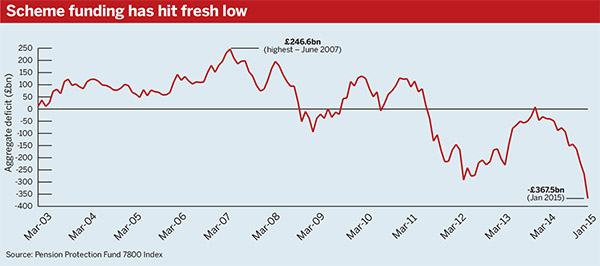The Pension Protection Fund’s latest 7800 Index figures showed further deteriorating funding deficits among defined benefit schemes, but industry commentators expressed caution against knee-jerk reactions to the slide.
The European Central Bank’s quantitative easing, plummeting oil prices driving down inflation and other economic factors have pushed gilt yields to rock-bottom levels, with 10-year UK gilts currently around 1.7 per cent.
This has increased liabilities among DB pension funds. PPF-eligible schemes face a combined deficit of £367.5bn – an all-time high since its creation in 2004 – having risen from £266.3bn since December 2014, according to figures released by the pensions lifeboat last week.

Paul Darlow, head of proposition development at consultancy Xafinity, said the figures must be analysed and understood fully.
“The end of January was a particularly bad date for gilt yields... but since January some of that reduction in gilt yields has already reversed out – something like 70 per cent of the drop we saw in Jan has already reversed,” he said.
According to Darlow, if trends continue UK schemes could see yields return to where they were in December 2014, easing the deficits faced by pension schemes.
The PPF agreed the figures should be viewed in context, adding: “These numbers are of course a snapshot: pension liabilities are long term and today’s numbers should be seen in that context.”
Tom McPhail, head of pensions research at Hargreaves Lansdown, also urged schemes and their members to look to the long term.
He said: “To some extent, in terms of the sustainability of the schemes, it’s important to focus on the horizon and not get too hung up on the short-term valuations [of the PPF index].”
On the growing liabilities of the schemes, McPhail added: “Falling gilt yields are doing the damage… but in the long term at some point you would expect very low current gilt yields – low by historic standards – to rise again. We just don’t know when.”
However, not everybody will be playing the waiting game for gilt yields to rise, especially those schemes or members that might not have the funding plan or patience to ride out a low-yield environment.
McPhail said this is where problems could arise, especially if pension schemes seek to take advantage of members wanting to transfer their money out of DB savings.
“Schemes do have latitude to reduce transfer values to reflect the current funding position of the scheme, and that does give me cause for concern.”
He said: “Members may opt to transfer out at a time which may prove to be a particularly inopportune moment.”
Trivial commutation
Darlow said some schemes would be taking measures to reduce their funding risk and suggested trivial commutation might be a favoured method.
“Trivial commutation is less about reducing liabilities, more about reducing risk. Reducing the admin burden is the main attraction of trivial commutation,” he said.
Martin Bird, senior partner at consultancy Aon Hewitt, said derisking strategies such as bulk annuities may be productive for schemes, despite the current deficit gaps.
He said: “What we are really seeing at the moment is very competitive annuity pricing for schemes invested in gilts… the increasing deficit is focusing people’s minds on risk management, and actually derisking through the purchasing of annuities is very attractive.”
Bird added longevity markets would be attractive, especially given they are less sensitive to interest rates.














